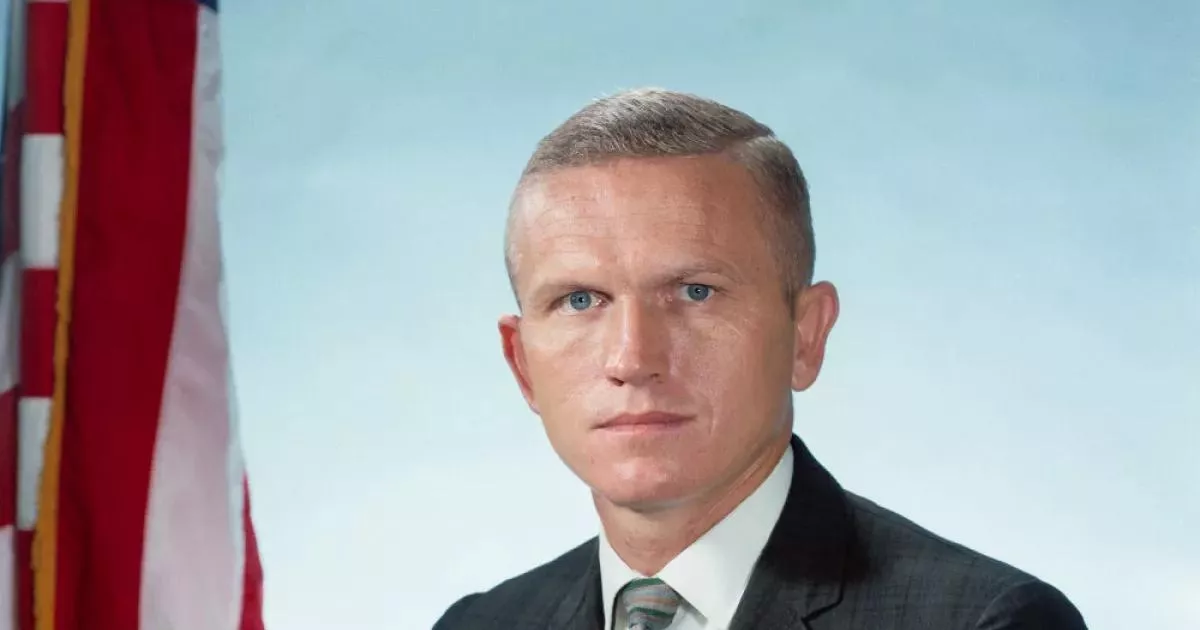"Frank Borman, a distinguished American figure, wore many hats including those of a USAF colonel, aeronautical engineer, NASA astronaut, test pilot, and businessman. His crowning achievement was commanding the Apollo 8 mission, the first to circumnavigate the Moon. This feat, accomplished alongside crewmates Jim Lovell and William Anders, placed them among the first 24 humans to orbit the Moon, an accomplishment for which he received the Congressional Space Medal of Honor.
March 14, 1928: Birth of Frank Borman
Frank Frederick Borman II was born on March 14, 1928, in Gary, Indiana. He was the only child of Edwin and Marjorie Borman.
1941: World War II and Early Aviation Experiences
After the US entered World War II in 1941, Borman's parents worked at an aircraft factory. This sparked Borman's interest in aviation, leading him to take flying lessons at age 15 and build model airplanes.
July 1, 1946: Entry into West Point
On July 1, 1946, Frank Borman entered the United States Military Academy at West Point, joining the Class of 1950.
June 2, 1950: Commissioning into the USAF
Borman was officially commissioned as a second lieutenant in the USAF on June 2, 1950, four days ahead of his West Point graduation.
June 6, 1950: Graduation from West Point
Frank Borman graduated from West Point on June 6, 1950, with a Bachelor of Science degree. He achieved the high ranking of eighth in his class.
July 20, 1950: Marriage to Susan
Borman married Susan on July 20, 1950, at St. Philip's in the Hills Episcopal Church in Tucson, Arizona. He had rekindled their relationship after his time at West Point.
August 1950: Beginning Flight Training
Borman started his basic flight training at Perrin Air Force Base in Texas in August 1950, learning to fly the North American T-6 Texan.
1950: Cadet Leadership and Football Involvement
During his final year at West Point in 1950, Borman served as a cadet captain, leading his company. He was also the manager of the varsity football team.
1950: Graduation from West Point and Commissioning into the USAF
Four days before graduating from West Point, Borman was commissioned into the United States Air Force (USAF) in 1950. He ranked eighth out of 670 graduates.
February 1951: Advanced Flight Training
Borman's advanced flight training began in February 1951 at Williams Air Force Base in Arizona. He trained on the North American T-28 Trojan and the F-80 jet fighter.
December 4, 1951: Earning Pilot Wings
Borman earned his pilot wings on December 4, 1951, marking a significant achievement in his aviation career.
December 20, 1951: Deployment to the Philippines
On December 20, 1951, Borman boarded the USNS Fred C. Ainsworth, a troop transport, and was deployed to the Philippines.
July 1952: Birth of Second Son
Borman's second son, Edwin Sloan, was born in July 1952 while he was stationed at Clark Air Base in the Philippines.
September 22, 1952: Flight Status Restored
After a period of restricted duties due to an eardrum injury, Borman's flight status was restored on September 22, 1952.
June 1957: Master of Science Degree
In June 1957, Borman received his Master of Science degree in aeronautical engineering from the California Institute of Technology.
1957: Master's Degree and Teaching Position
Borman earned a Master of Science degree from Caltech in 1957. He became an assistant professor at West Point, teaching thermodynamics and fluid mechanics.
June 1960: Selection for Test Pilot School
In June 1960, Borman was selected for Class 60-C at the USAF Experimental Flight Test Pilot School.
1960: Test Pilot Training and Aerospace Research
In 1960, Borman completed training at the USAF Experimental Flight Test Pilot School and became a qualified test pilot. He was then selected for the prestigious Aerospace Research Pilot School.
April 21, 1961: Graduation from USAF Experimental Flight Test Pilot School
On April 21, 1961, Borman graduated from Class 60-C at the USAF Experimental Flight Test Pilot School at Edwards Air Force Base in California, becoming a test pilot.
April 18, 1962: NASA Announces New Astronaut Applications
On April 18, 1962, NASA formally announced that it was accepting applications for a new group of astronauts.
May 1962: USAF Astronaut Selection Process
In May 1962, the USAF conducted its internal selection process for astronaut candidates, putting them through a brief training course on public speaking and conduct.
September 17, 1962: Selection as One of the Next Nine Astronauts
Borman's selection as one of the Next Nine astronauts was publicly announced on September 17, 1962.
1962: Selection as a NASA Astronaut
Frank Borman was chosen to be a NASA astronaut in 1962 as part of the 'Next Nine' group.
October 1963: Replacement on Gemini 3 Crew
When Shepard was grounded in October 1963, Grissom and Borman initially became the prime crew of Gemini 3, but Slayton replaced Borman with John Young due to personality conflicts.
July 27, 1964: Assignment as Backup Commander of Gemini 4
Borman was assigned as backup commander of Gemini 4, with Jim Lovell as his co-pilot, officially announced on July 27, 1964.
July 1, 1965: Assignment to Gemini 7
Borman's assignment to Gemini 7 as backup commander, with Ed White and Michael Collins as backups, followed on July 1, 1965.
December 6, 1965: Launch of Gemini 7
Gemini 7, with Borman on board, was launched at 14:30 local time on December 6, 1965, starting the mission and the race to launch Gemini 6.
1965: Harmon Trophy for Gemini 7
In 1965, Frank Borman, along with his Gemini 7 crewmate Jim Lovell and the Gemini 6 crew, received the Harmon Trophy.
December 22, 1966: Official Announcement of Apollo Crew Selection
Borman's selection as commander of the fourth Apollo mission, with Michael Collins as the senior pilot and Bill Anders as the pilot, was officially announced in a NASA press release on December 22, 1966.
1966: Gemini 7 Mission and Endurance Record
Borman commanded the Gemini 7 mission in 1966, setting a record for a fourteen-day spaceflight.
1966: Stock Value Decline
The value of Eastern Air Lines' stock experienced a significant decline from $60 per share in 1966.
January 27, 1967: Apollo 1 Fire
On January 27, 1967, tragedy struck the Apollo program when a fire aboard the Apollo 1 command module claimed the lives of astronauts Gus Grissom, Ed White, and Roger B. Chaffee. This event had a profound impact on the future of the Apollo program.
April 1967: Apollo 1 Accident Review Board Testimony
In April 1967, following the Apollo 1 fire, Frank Borman, as a member of the accident review board, provided crucial testimony before the United States House of Representatives and Senate committees. His testimony aimed to assure Congress of the safety of continuing the Apollo program.
November 20, 1967: Apollo Crew Assignments Announced
On November 20, 1967, crew assignments for upcoming Apollo missions were officially revealed. These announcements signified progress in the Apollo program.
June 1968: LM-3 Defects Discovered
The arrival of the Apollo 8 lunar module (LM-3) at Kennedy Space Center (KSC) in June 1968 brought to light a significant number of defects. These technical challenges posed a threat to the mission's timeline.
July 1968: Collins Replaced by Lovell
Astronaut Michael Collins, originally slated for an Apollo mission, experienced a medical issue requiring surgery in July 1968. As a result, Jim Lovell joined the crew, reuniting with his Gemini 7 crewmate, Frank Borman.
August 1968: Proposal for CSM-Only Mission
In August 1968, a proposal emerged for a Command/Service Module (CSM)-only mission, driven by concerns about the Soviet Union's lunar ambitions. This proposal aimed to maintain the Apollo program's momentum.
December 1968: CSM-Only Mission to the Moon
December 1968 saw the execution of the CSM-only mission, sending a spacecraft to orbit the Moon before returning to Earth. This mission marked a significant step in human exploration of space.
December 1968: Apollo 8 Mission and Christmas Eve Broadcast
In December 1968, Frank Borman commanded the Apollo 8 mission, which became the first to fly around the Moon. The mission is famous for the "Earthrise" photograph and the Christmas Eve broadcast from lunar orbit, where the crew read from the Book of Genesis.
December 1968: Low Earth Orbit Mission Planned
In December 1968, a low Earth orbit mission was part of the Apollo program's agenda. This mission played a role in the lead-up to later lunar missions.
December 21, 1968: Apollo 8 Launch and Borman's Illness
Apollo 8 launched on December 21, 1968. During the mission, Frank Borman experienced illness, including vomiting and diarrhea, later attributed to space adaptation syndrome. Despite this, the crew successfully completed their mission.
1968: Multiple Awards for Apollo 8
In 1968, Frank Borman and the Apollo 8 crew were awarded several honors including the Harmon Trophy, Robert J. Collier Trophy, General Thomas D. White USAF Space Trophy, and the National Geographic Society's Hubbard Medal.
1968: Academy of Model Aeronautics Distinguished Service Award
In 1968, Frank Borman was awarded the Academy of Model Aeronautics Distinguished Service Award.
1968: Borman Offered Moon Landing Command
In 1968, Frank Borman was offered the command of the first Moon landing attempt but declined. He had already decided that Apollo 8 would be his last mission.
1968: End of a Tumultuous Year and Apollo 8's Impact
The year 1968 was marked by significant global events and turmoil. Apollo 8's mission, with its success in orbiting the Moon, had a profound impact on society, offering a glimmer of hope and achievement.
January 3, 1969: Time Magazine Men of the Year
On January 3, 1969, the crew of Apollo 8, including Frank Borman, was featured on the cover of Time magazine as its Men of the Year for 1968.
July 1969: Borman as NASA Liaison for Apollo 11
During the Apollo 11 Moon landing mission in July 1969, Frank Borman served as NASA's liaison to President Richard Nixon. He played a crucial role in managing communication and events related to the mission.
1969: Advisor to Eastern Air Lines
Frank Borman began working as a special advisor to Eastern Air Lines in early 1969.
1969: Golden Plate Award
In 1969, Frank Borman received the Golden Plate Award of the American Academy of Achievement for the science and exploration category.
1969: Early 1969 Apollo Mission
In early 1969, an Apollo mission was planned, representing a step closer to the ultimate objective of landing humans on the moon.
1969: Eastern Air Lines' Financial Struggles
It's noted that Eastern Air Lines had not generated a profit since 1969.
1969: Lunar Landing Scheduled
The year 1969 held the highly anticipated event of a lunar landing, representing the culmination of years of planning and preparation in the Apollo program.
June 1970: Borman's Retirement from NASA and Air Force
Frank Borman retired from both NASA and the United States Air Force in June 1970. He cited personal reasons, including family stress, as factors in his decision.
July 1, 1970: Joining Eastern Air Lines
On July 1, 1970, Frank Borman officially joined Eastern Air Lines and relocated to Miami.
August 1970: Presidential Mission to Seek Release of POWs
In August 1970, Frank Borman embarked on a presidential mission, traveling the world to advocate for the release of American prisoners of war held in North Vietnam. While the mission did not fully achieve its objectives, Borman played a role in raising awareness and advocating for the humane treatment of POWs.
1970: Retirement and Move into the Corporate World
Borman retired from NASA and the Air Force in 1970. He transitioned to a corporate career, taking on a senior vice president role at Eastern Air Lines.
1970: Borman's Planned Retirement
Frank Borman planned to retire in 1970, after two decades of service in the Air Force, making him eligible for a pension.
December 29, 1972: Eastern Air Lines Flight 401 Crash
On December 29, 1972, Frank Borman received news of the Eastern Air Lines Flight 401 crash. He personally participated in the rescue efforts, reaching the crash site by helicopter and aiding survivors.
July 1974: Promotion and Board Membership
In July 1974, Frank Borman was promoted to executive vice president-general operations manager and joined Eastern Air Lines' board of directors.
1974: Bribery Accusations and Clearing of Charges
In 1974, Frank Borman's son, Frederick, a West Point cadet, faced accusations of accepting a bribe to influence an honor code case. However, he was cleared of all charges after undergoing a polygraph test.
May 1975: President and COO
Frank Borman was elected as the president and chief operating officer of Eastern Air Lines in May 1975.
December 1975: Chief Executive Officer
In December 1975, Frank Borman assumed the role of chief executive officer at Eastern Air Lines.
1975: CEO of Eastern Air Lines
In 1975, Borman was appointed as the Chief Executive Officer of Eastern Air Lines.
1975: Allegations Against Younger Son
In 1975, allegations of impropriety were made against Frank Borman's younger son, Edwin, also a West Point cadet. However, these allegations were found to be unsubstantiated and were dismissed.
December 1976: Chairman of the Board
Frank Borman's leadership at Eastern Air Lines continued as he became chairman of the board in December 1976.
1976: Chairman of the Board at Eastern Air Lines
Borman's role at Eastern Air Lines expanded in 1976 when he became Chairman of the Board.
1976: Wage Freeze Agreement
In 1976, Frank Borman successfully negotiated a wage freeze with Eastern Air Lines employees to cut costs, promising an eight percent raise in 1977.
1976: James H. Doolittle Award
In 1976, Frank Borman was awarded the Society of Experimental Test Pilots James H. Doolittle Award.
1976: West Point Cheating Scandal Investigation
In 1976, a major cheating scandal rocked the United States Military Academy at West Point. Frank Borman was appointed to lead a special commission tasked with investigating the matter and providing recommendations to the Secretary of the Army.
1977: Variable Earnings Program (VEP)
Following the wage freeze, a five-year Variable Earnings Program (VEP) was introduced in 1977, where employee contributions were linked to the company's profitability.
October 1, 1978: Congressional Space Medal of Honor
On October 1, 1978, Frank Borman was awarded the Congressional Space Medal of Honor for his command of Apollo 8.
1978: Record Profits and Refinance
Eastern Air Lines achieved record profits of $67.3 million in 1978, allowing Borman to refinance the company's debt and reward employees with double their VEP payments.
1978: Resolution of West Point Cheating Scandal
Following the investigation into the West Point cheating scandal, a resolution was reached in 1978. Some cadets involved were readmitted and allowed to graduate, while others declined amnesty and pursued their education elsewhere.
1978: Airline Deregulation Impact
The airline industry experienced deregulation in 1978, leading to increased competition, which contributed to Eastern Air Lines' financial challenges.
1979: Last Profitable Year
The year 1979 marked the end of Eastern Air Lines' profitable period until 1985.
1982: Inductions into International and National Aviation Halls of Fame
In 1982, Frank Borman was inducted into the International Space Hall of Fame and the National Aviation Hall of Fame.
1983: Further Stock Value Decline
By 1983, the value of Eastern Air Lines' stock had plummeted to $6 per share.
1984: Profit and Layoffs
Despite posting a profit in 1984, Eastern Air Lines still faced pressure from creditors. Borman made further cost-cutting decisions, including layoffs and pay cuts for flight attendants and executives.
1984: Significant Losses and Negotiations
Eastern Air Lines incurred substantial losses in the first three quarters of 1984. Borman engaged in negotiations with unions, securing pay cut agreements in exchange for company stock.
1985: Financial Losses and Debt
Between 1980 and 1985, Eastern Air Lines faced significant financial losses, accumulating $380 million in losses and facing a high debt-to-equity ratio.
1985: Consecutive Profitable Quarters
Eastern Air Lines achieved three consecutive quarters of profit, but Borman's attempts to negotiate further cuts with unions faced resistance, particularly from the IAM.
June 1986: Resignation and Sale to Texas Air Corporation
Facing an impasse with the IAM and under pressure to improve the company's financial situation, Eastern Air Lines' board decided to sell the airline to Texas Air Corporation. Frank Borman resigned from his position in June 1986.
1986: Resignation from Eastern Air Lines
Following challenges with deregulation, debt, and labor disputes, Frank Borman resigned from his position at Eastern Air Lines in 1986.
1986: Aircraft Crash Inquiry
In 1986, Frank Borman participated in a South African Board of Inquiry tasked with investigating the aircraft crash that resulted in the death of Mozambican president Samora Machel.
1986: Tony Jannus Award
In 1986, Frank Borman received the Tony Jannus Award.
July 1988: CEO of Patlex Corporation
Frank Borman took on the role of CEO at Patlex Corporation, a company specializing in laser patents, starting in July 1988.
1990: Airport Operators Council International Downes Award
In 1990, Frank Borman was awarded the Airport Operators Council International Downes Award.
1990: Arizona and International Air & Space Hall of Fames
In 1990, Frank Borman was inducted into the Arizona Aviation Hall of Fame's inaugural class and the International Air & Space Hall of Fame.
1991: Severance and Consulting Fees
Following his resignation, Borman received a severance payment and continued to receive consultant fees from Eastern Air Lines until 1991.
1993: U.S. Astronaut Hall of Fame
In 1993, Frank Borman was inducted into the U.S. Astronaut Hall of Fame.
August 1996: Autobiography Publication
Borman stepped down from his position at Patlex Corporation in August 1996 and published his autobiography, "Countdown," co-authored with Robert J. Serling.
1998: Cattle Ranch and Model Airplanes
In 1998, Frank Borman purchased a cattle ranch in Montana, pursuing his interest in ranching. He continued his hobby of building and flying model airplanes, notably restoring a Bell P-63 Kingcobra.
1999: Borman's Interview about Apollo Program
In a 1999 interview, Borman shared his perspective on the Apollo program, emphasizing his commitment to the mission's success rather than personal goals.
2005: Feature in PBS Documentary
In 2005, Frank Borman appeared in the documentary Race to the Moon, which was part of the PBS American Experience series and focused on the events leading up to Apollo 8.
November 13, 2008: Apollo 8 Discussion on NASA TV
On November 13, 2008, Frank Borman, along with Jim Lovell and Bill Anders, appeared on the NASA TV channel to discuss Apollo 8 on the 40th anniversary of the mission.
2008: Commencement Address at University of Arizona
In 2008, Frank Borman gave the commencement address to the University of Arizona's graduating class.
2012: NASA Ambassador of Exploration Award
In 2012, Frank Borman received the NASA Ambassador of Exploration Award.
December 2016: Oldest Living American Astronaut
Following John Glenn's death in December 2016, Frank Borman became the oldest living American astronaut. He was eleven days older than his Apollo 8 crewmate, Jim Lovell.
March 2018: 90th Birthdays Celebration
In March 2018, Frank Borman and Jim Lovell celebrated their 90th birthdays. Borman was eleven days older than Lovell.
August 24, 2018: Interview on This American Life
On August 24, 2018, Frank Borman was featured on Episode 655 of the radio program This American Life titled "The Not-So-Great Unknown", where he discussed his unconventional outlook towards space travel.
December 2018: 50th Anniversary of Apollo 8
In December 2018, Frank Borman was reunited with his Apollo 8 crewmates, Jim Lovell and Bill Anders, to celebrate the 50th anniversary of the mission at the Museum of Science and Industry in Chicago.
September 7, 2021: Susan Borman's Passing
Frank Borman's wife, Susan, who had been battling Alzheimer's disease, passed away on September 7, 2021.
November 7, 2023: Death of Frank Borman
Frank Borman passed away on November 7, 2023. He was known for being the commander of Apollo 8, the first mission to fly around the Moon.
Mentioned in this timeline
Home Box Office HBO is an American pay television service...
California is a U S state on the Pacific Coast...
The Union of Soviet Socialist Republics USSR existed from to...

Christmas is an annual festival celebrated on December th commemorating...
NASA the National Aeronautics and Space Administration is an independent...
Arizona is a landlocked state in the Southwestern U S...
Trending
Cristela Alonzo is an accomplished American stand-up comedian actress writer and producer She made history as the first Mexican American...
26 days ago Marcus Freeman: Notre Dame coach considered for Giants head coaching vacancy in NFL.
2 months ago ACA Subsidies Expiration Fuels Premium Fears Amid Government Shutdown, Impacting Covered California

1 month ago Cam Newton Reacts to Drake Maye's Taunt; Patriots Champ Rips Newton's Criticism.

2 months ago Upstart's Q3 Earnings: Mixed Results, Soft Q4 Guidance, and Stock Slides After Announcement.
2 months ago Great Salt Lake Dust Cost Revealed; Ogden Canyon Restaurant Set to Reopen.
Popular

Stranger Things created by the Duffer Brothers is a popular...

XXXTentacion born Jahseh Dwayne Ricardo Onfroy was a controversial yet...
The Kennedy Center Honors are annual awards recognizing individuals and...
Turning Point USA TPUSA is an American nonprofit organization founded...

Bernie Sanders is a prominent American politician currently serving as...

Candace Owens is an American conservative political commentator and author...
